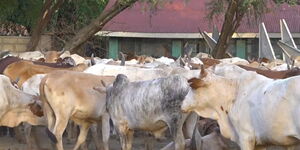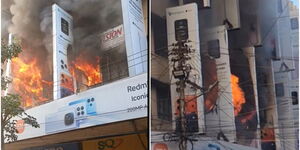James Orengo, the Siaya County Governor, now claims that the State borrowed six precolonial tactics to quell protests that erupted over the cost of living.
While addressing mourners in Siaya on Friday, August 11, Orengo claimed that the strategies had never been used since Kenya got its independence and even during the single-party ruling by the late President Daniel arap Moi.
Among them was the scorched earth military policy, deploying snipers and furnishing anti-riot police with handguns
The opposition politician and veteran activist added that police also planned the execution of protesters who were eulogised during the inter-denominational requiem mass held in Siaya County.
"Raila and I have been to protests since Jomo Kenyatta's era, but I have never seen the kind of savagery that was meted on the innocent protesters all across the country," Orengo lamented.
Kenyans.co.ke could not independently verify Orengo's claims. Inspector General of the National Police Service (NPS), Japhet Koome, also distanced his juniors from extra-judicial claims and alleged that the opposition hired the dead bodies to taint their reputation.
1. Assault Rifles
Orengo, who did not adduce any evidence, claimed that police officers used extra-ordinary assault rifles, which are selective-fire guns that use an intermediate cartridge and a detachable magazine.
He claimed that, as part of the strategy, the weapons were meant to cause maximum damage to protesters.
2. Handguns
Orengo also stated that the police officers used handguns, a type of firearm which is small enough to be held and fired with one hand, unlike long guns such as rifles, shotguns, submachine guns, or machine guns.
Handguns are the most common type of firearms, and they include revolvers and semi-automatic pistols, although other types, such as derringers and machine pistols, are not often used.
Kenya National Police Service often use Glock pistols manufactured by an Austrian company, Glock. They include Glock 17, Glock 19, and Glock 22.
"Police officers were recorded while waylaying protesters around the corner and killed them using handguns," Orengo claimed.
3. Police Sniper with Revolver
The Siaya County Governor claimed that the National Police Service also deployed snipers specially trained to engage targets from long distances.
Orengo lamented that the snipers who are often used in SWAT teams and are called upon to de-escalate situations posing a high-risk danger to the public, such as hostage situations, barricaded suspects, and active shooters.
"The snipers accurately hit the protesters at long distances. They were able to move stealthily and undetected after gathering intelligence on where the demonstrators were," he claimed.
Reports alleged that SWAT teams were responsible for multiple deaths in Mlolongo, along Mombasa Road, contrary to police reports.
4. Militarised Water Canons
According to Orengo, the anti-riot squads used militarised water cannons, which should not be used to disperse civilians but rowdy crowds.
The Siaya Governor explained that the militarized water cannons were typically much larger and more powerful than civilian cannons.
He explained that the new militarized water cannons were equipped with additional features such as tear gas launchers, sound cannons, and pink water and pepper spray dispensers.
"These features were used to further incapacitate and disperse crowds, and they can also be used to protect the operators of the water cannon from being attacked by protesters," Orengo stated.
5. Police failed to Record Statements
Senior Counsel Orengo alleged that police officers who used bullets violated Section 32 of the National Police Service Act, 2011, which requires police officers who use force, including deadly force, to record a statement within 24 hours of the incident.
He added that the statement must be recorded in the presence of a lawyer or a police officer of a higher rank and be made available for scrutiny by the Independent Policing Oversight Authority (IPOA).
"The purpose of this requirement is to ensure that police officers are held accountable for their actions when they use force, especially deadly force. The statement provides a record of the incident and the officer's account of what happened. This can be used to investigate the incident and to determine whether the officer's use of force was justified," Orengo stated.
6. Scorched Earth Policy
Governor Orengo claimed that police officers received orders to use the scorched earth policy, a tactic that gained prominence during World War II, to deny the enemy resources.
A scorched earth policy is a military strategy of destroying the enemy's key resources including water, food, humans, animals, plants and infrastructure.
Orengo was alluding to instances where police officers allegedly burnt down businesses and invaded homes while searching for protesters.
The governor promised to cite local and international laws to bring the police to justice. Opposition leader and former Prime Minister, Raila Odinga, also condemned police for using extra force to quell protests.












